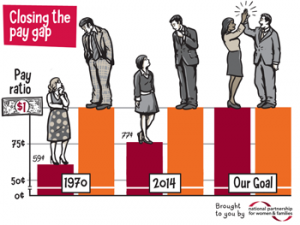 It’s 2014 and women are still getting paid less than men in the workforce. While we’re all aware that this is happening, what’s less clear is why it’s happening. Earlier this month, some politicians voted down the equal pay bill by saying “There’s a disparity not because female engineers are making less than male engineers at the same company. The disparity exists because a female social worker makes less than a male engineer.” This statement implies that women get paid less than men because they choose to work in lower-paying jobs—but this is wrong. The majority of the pay gap between men and women “comes from differences within occupations, not between them.” Harvard University labor economist and scholar, Dr. Claudia Goldin calculated that placing more women into higher-paying occupations would “erase just 15 percent of the pay gap for all workers,” and the rest of the pay gap problems stem from within the workplace. In the medical industry, for example, women doctors and surgeons earn only 71% of men’s wages, even when controlling for age, race, hours, and education!
It’s 2014 and women are still getting paid less than men in the workforce. While we’re all aware that this is happening, what’s less clear is why it’s happening. Earlier this month, some politicians voted down the equal pay bill by saying “There’s a disparity not because female engineers are making less than male engineers at the same company. The disparity exists because a female social worker makes less than a male engineer.” This statement implies that women get paid less than men because they choose to work in lower-paying jobs—but this is wrong. The majority of the pay gap between men and women “comes from differences within occupations, not between them.” Harvard University labor economist and scholar, Dr. Claudia Goldin calculated that placing more women into higher-paying occupations would “erase just 15 percent of the pay gap for all workers,” and the rest of the pay gap problems stem from within the workplace. In the medical industry, for example, women doctors and surgeons earn only 71% of men’s wages, even when controlling for age, race, hours, and education!
Dr. Goldin describes how the wage disparities lie in workplace flexibility in terms of hours and location. Dr. Goldin writes “The gender gap in pay would be considerably reduced and might vanish altogether if firms did not have an incentive to disproportionately reward individuals who labored long hours and worked particular hours.” Indeed, occupations that value long hours tend to have the widest wage gaps. Dr. Goldin found that employers compensated those who spend longer hours at the office disproportionately more than they pay employees who do not. In other professions, the pay gap is smallest when one employee can be easily substituted for another and the workers are paid in proportion to the hours worked. Women with children have been found to value flexibility in their schedules or to work remotely at times--a problem within the current value/reward system within professions that value long hours. Until employees and professions learn to be flexible and equitable between the sexes, wage disparities will continue to persist.
Source: The New York Times


 The American Association of University Women (AAUW) recently published a report indicating that the pay gap, or the earning difference between men and women, is still an issue today, and often manifests in the very first paycheck a female college graduate receives. The
The American Association of University Women (AAUW) recently published a report indicating that the pay gap, or the earning difference between men and women, is still an issue today, and often manifests in the very first paycheck a female college graduate receives. The  For women, it has been a long struggle to reach the executive suite. Research by Assistant Professor
For women, it has been a long struggle to reach the executive suite. Research by Assistant Professor